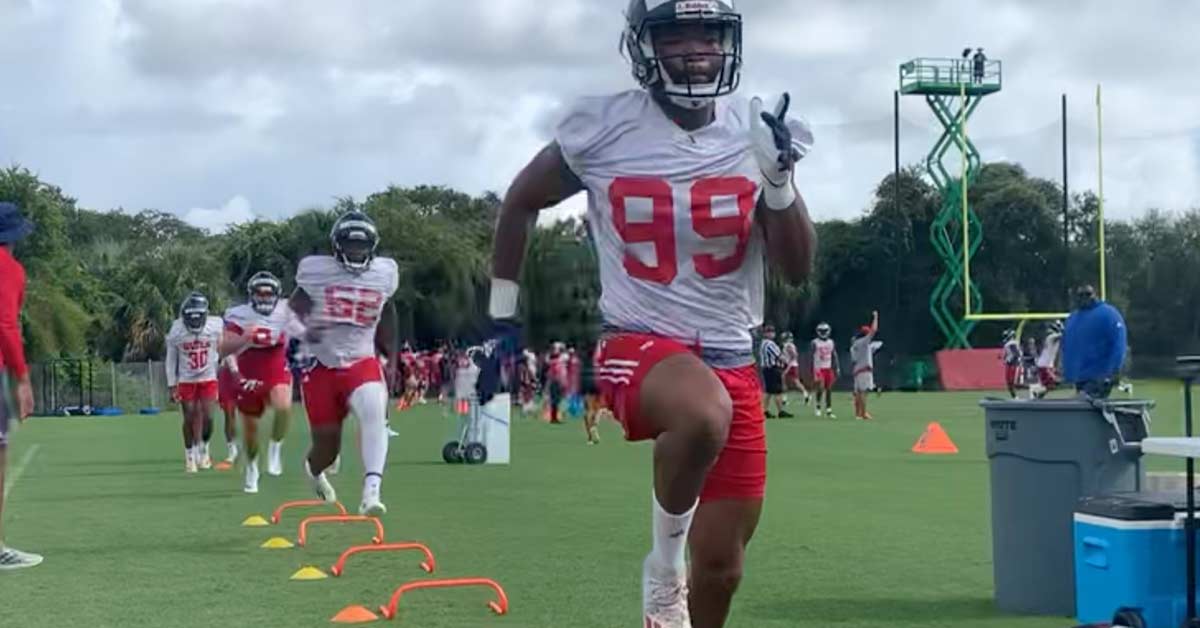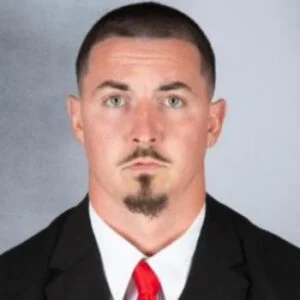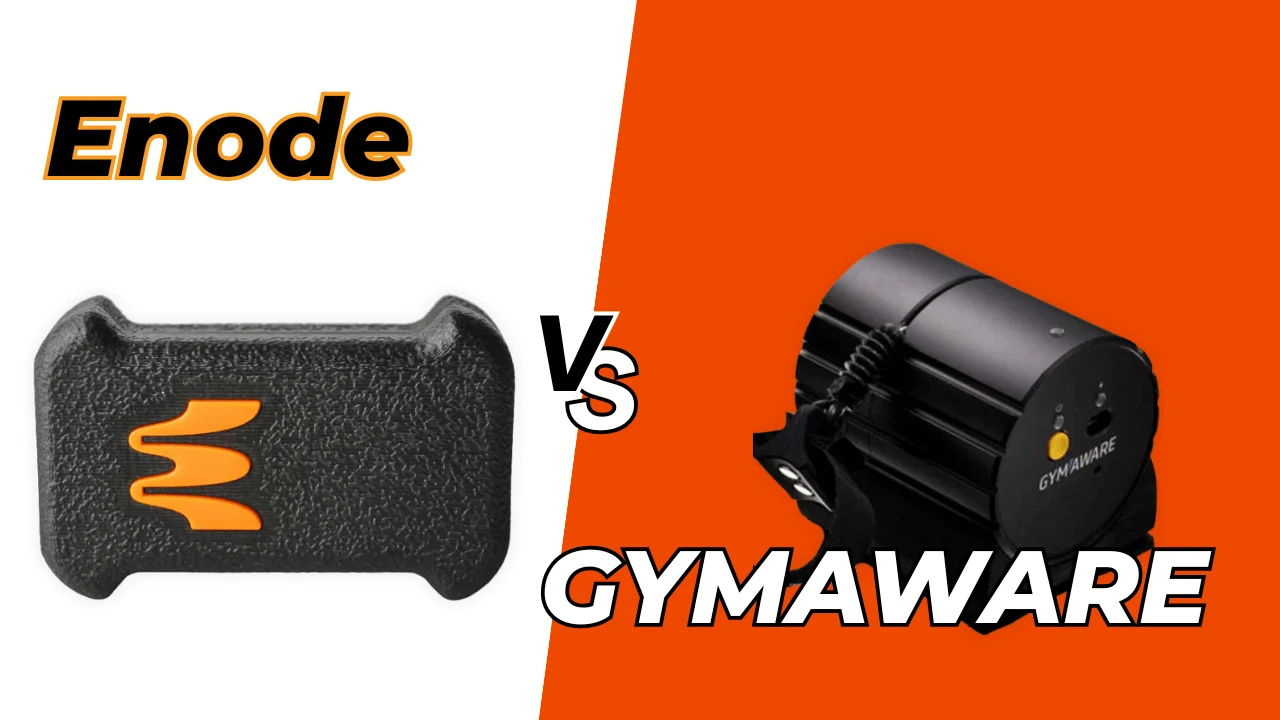By Joey Guarascio, Autumn Bartlett, and Adam Bennett
In-season, planning football training exercises, prescribing the right amount of stress, and allowing the proper recovery periods are all essential for performance in games. Throughout the off-season, the strength and conditioning coaches calculate and prescribe workouts down to the pound or yard—this same precise approach must be taken in-season. The challenge, though, is whereas everything can be preemptive in planning in the off-season, the in-season is very much reactive due to the chaotic and unpredictable nature of the game.
Having all departments in the organization on the same page is a must, as there needs to be maximum communication throughout about the current state of the team and individual players. When your job is dependent on production, you cannot leave anything to chance. The football coaches, ATC, strength and conditioning coaches, and nutritionist all need to move information fluidly back and forth to manage stress and have proper planning for future practices.
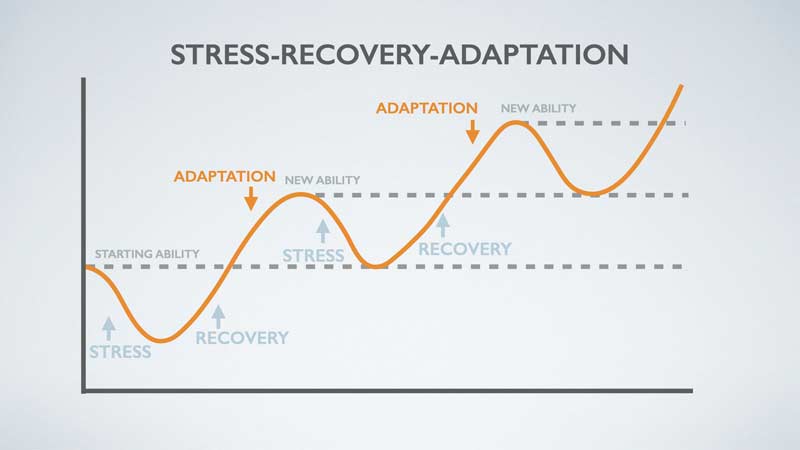
Performance isn’t about how much stress a coach can impose on the athlete, but about how much volume of stress the athlete can recover from and adapt to, and then go and compete again. It is taking the science and data and turning it into usable and actionable means. Aiding this process with recovery resources, from percussive therapy tools to supplements and shakes to recovery training circuits, can take a lot of uncertainties out of the equation and helps mitigate issues as much as possible. Coaches can’t control everything, but we strive to aid in victory as much as possible—otherwise, what’s the alternative? Do we do nothing and allow 18- to 22-year-olds to fend for themselves? Or do we educate and teach proper habits that enhance general well-being and maximize recovery?
Performance isn’t about how much stress a coach can impose on the athlete, but about how much volume of stress the athlete can recover from and adapt to, and then go and compete again. Share on XIn this article, you will get perspectives from three different departments of FAU football:
- Strength and Conditioning
- Sports Nutrition
- Athletic Training
These separate departments need to work as one to make sure we arrive on game day ready to perform. We provide a daily outline from Sunday (six days out) to Saturday (game day) with all the interventions we take.
[adsanity align=’aligncenter’ id=11130]
Sunday: Six Days Out from Game Day
Following a Saturday game, players get to sleep in on Sunday morning. Our first required team activity on Sundays is a medical check-in, scheduled at noon. The check-in is mandatory for all participants in the game the night before. The ATC screens out any uninjured athletes first (as all participants are required to check in), before then addressing potential injured athletes.
The ATC starts with general questions surrounding the injury before engaging in further testing. The results of the medical check-in are communicated directly to the strength and conditioning staff, who prepare for any alterations of the day’s lift and practice. The ATC expresses the severity of the injury, limitations, mechanism, and potential time frame of future evaluations or rehab. They visit before the full staff meeting and run down the list of guys that have something going on that we need to be aware of.
When making alterations, we like to use plan B, which is the next-closest exercise that the athlete can accomplish given their limitations. An example would be if we prescribe a split squat, but the athlete has a foot injury, we could accomplish the same goal as the prescribed football training exercises with a rear-foot-elevated split squat or a pistol squat, which fits the lateralization of our split squat. This communication is key and is the lifeblood of any performance team.
When making alterations, we like to use plan B, which is the next-closest exercise that the athlete can accomplish given their limitations. Share on XAfter the medical check-in, players proceed to brunch, as this is usually their first meal of the day—they typically sleep in until around 10-11 a.m. the morning after a game. At brunch, they check in with a nutritional intern to have their body weight checked. If there is a significant loss in BW (2%-4%), our nutritionist is alerted.
The first line of defense that the nutritionist takes is hydration intervention. The athlete is provided with a Right Stuff, a Liquid IV, and a 16-ounce Powerade bottle that they must drink. Each player has a custom plate assembled by the nutritional staff, depending on their nutritional goals (weight gain, weight loss, or maintain). The meal is carb-/protein-heavy to replenish what was burned the night before.
Players then report to the weight room, where they perform a 28-minute recovery circuit along with a light, regenerative lift that emphasizes restoring ROM back into the foundational movement patterns such as squat, hinge, press, and a pull. We are not trying to reinvent the wheel with the recovery circuit; we are looking to:
- Decrease general soreness.
- Increase ROM in primary movers.
- Decrease muscle tone to avoid pulls or allow compensations to form.
We use several tools, such as Donnie Thompson’s tempering rollers, the Theragun, and the PainPill from Chris Duffin. The Theragun is an amazing product because it allows us to pinpoint some specific areas that cannot be reached with general rollers.
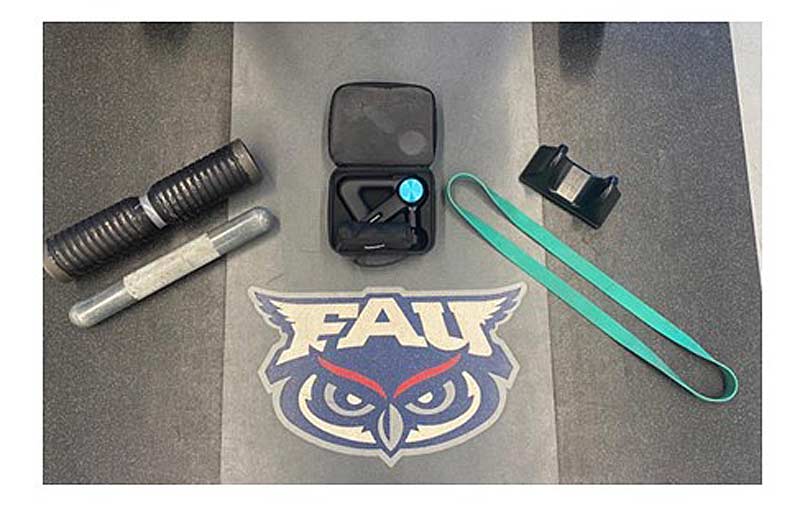
Recovery Circuit – Seven-minute stations (athletes rotate through all four):
- Self myofascial release (SMR): body tempering, manual therapy, and Theragun to pinpoint sore spots.
- Hurdle mobility.
- Athlete yoga.
- Band stretch.
Once the players have run through the recovery circuit, they report to their assigned racks and begin the lift pictured below under the S&C coaches’ watch.

Post-lift, the players are given a recovery shake high in carbs, protein, and anti-inflammatories such as cherry juice and berries. The players are also given a multivitamin and fish oil. The shakes are customized to fit the requirements of the athlete’s desired body comp goal.
Players go to meetings post-lift, followed by a correction-styled practice to clean up mistakes from the previous game (this lasts an hour in duration). We steal some more recovery with our pre-practice warm-up, utilizing some mobility exercises.
To finish out the day, our players get to (hopefully) eat a victory meal from our training table while watching NFL games. This is usually a specialty meal and allows for the players to decompress and enjoy each other’s company.
Monday: Five Days Out from Game Day
Monday is a mandatory off day where the players can catch up on sleep and handle academic work. We encourage SMR (body tempering, manual, Theragun), general stretching, and meathead work to maintain some body armor (back machine work, push-ups, arm farm, neck work). We also provide an at-home recovery plan if the player doesn’t want to come to the facility.
If the athlete chooses to come in voluntarily, it’s another opportunity for the athlete to be provided with nutritional resources. The weight room observes open hours from 8 a.m.-4 p.m. and the training room requires that two treatment times (8 a.m.-11 a.m., 1 p.m.-3 p.m.) are met. The treatment/rehab sessions are longer treatment session times to prep for the week. Any changes in a player’s injury status are discussed with the strength and conditioning staff as well as the football staff.
It’s great for the players to get away from the stress of competition and reset before the challenges of the next opponent are presented.
Tuesday: Four Days Out from Game Day
Tuesday is a workday! Tuesday starts with a mandatory breakfast that is carb-centered to fuel the players for the upcoming full-padded practice. At breakfast, the strength staff is present and taking general soreness questionnaires for our two deep. This info is relayed to the ATCs, and players with a rating of 4/10 are recommended to come get extra recovery or treatment on the specific troubled area. We utilize a 0 (no pain) to 10 (need to see a doctor) scale for this questionnaire.
AM treatments are performed concurrently while breakfast is open. AM treatments are focused on prepping athletes for practices. The main purpose is to enable heavier modalities and be soft-tissue-based. The pre-practice rehab design is to prep the body for work. Tools such as BFR Air Band Cuffs are prescribed with football training exercises to reduce stress on the joints and bring blood flow to specific issue areas. Activation exercises are also prescribed to maximize output for the day’s work.
Video 1. Tuesday is a great day to utilize a max-velocity-themed warm-up pre-practice. The use of pogo hops, dribbles, and skips allows the athlete to retain the reactive strength and speed mechanics that were developed over the off-season.
Pre-practice warm-up for Tuesday is max-velocity-themed to retain and touch on the reactive strength components and technical components that were developed throughout the off-season. Pogo hops, skips, and dribbles are all used to refresh the athletic qualities of speed and reactive strength that can be lost in less than seven days. In-season football training exercises—from a strength and conditioning coach’s perspective—are all about allowing the athletes to maintain and gain increases in the general athletic qualities that were developed during the off-season.
Direct reactive strength training is one that, through testing depth jumps in-season, was shown to be a detrained athletic quality as the season went on. Share on XWhen the stimuli are provided through the sport, it isn’t necessary to compile the stress through training modalities. It’s extremely important to understand which boxes are being checked and which ones aren’t. Direct reactive strength training is one that, through testing depth jumps in-season, was shown to be a detrained athletic quality as the season went on. The intervention of reactive strength work in our warm-up on Tuesdays combatted this and led to higher max velocities on average in the practice.
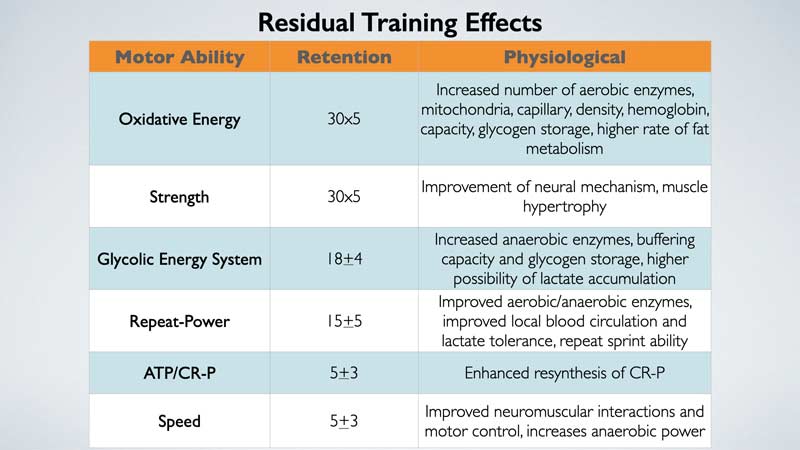
The practice is around two hours and 15 minutes and is centered on first and 10 play options and is also special teams heavy. Due to the situational down and distance, Tuesday’s practice demands more overall volume and high-speed volume for the players. In this practice, we encourage our players to try and match or surpass their best padded max velocity.
Hitting a minimum 90% of max velocity twice a week is necessary to maintain speed in-season from the data we have collected. Speed interventions will be made if that is not being accomplished by having the athlete hit one fly-10 with a 30-yard build on Thursday. Monitoring max velocity and implementing a max velocity warm-up have really helped in the reduction of soft tissue injuries.
During the practice, right around the mid-point, the coach has a 10-minute period we call halftime—here, the players sit down under tents with fans, replenish glucose, and hydrate. We supply several different snacks that range from fruit to candy. We want to practice at a high level, which means having enough gas in the tank to accomplish that.
Monitoring max velocity and implementing a max velocity warm-up have really helped in the reduction of soft tissue injuries. Share on XPost-practice, players are provided with a carb recovery shake immediately as they walk off the field. The players have 15 minutes to change and begin their post-practice lift. We try to maximize their time by stacking the lift and practice. The travel squad, which includes around 50 players, gets their main lift of the week post-practice on Tuesday. I am in favor of a post-practice lift as opposed to pre-practice lift for several reasons:
- Practice the sport in a fresh state. (It’s football season—keep the main thing the main thing.)
- Lifting is supportive.
- Allows for more aggressive load prescription, knowing that players don’t have anything except classes afterward.
- Allows for more autoregulation based on practice stress.

Post-lift, a custom shake based on a weight gain, lose, or maintain distinction is waiting for the athlete with a high-carb and -protein lunch to go. Athletes who had high scores on their daily soreness charts have the option to come back in the afternoon to get extra treatment on specified areas. Athletes returning from long-term injuries come back in the afternoon for rehab.
We also encourage our athletes on Tuesday to take advantage of our cold and hot tubs. Contrast bath modality is as follows:
- 3-minute cold, 2-minute hot x 2 cycles + end with 3-minute cold.
Normatec recovery boots are also available to increase the recovery process—the recovery boots are a player favorite.
[adsanity align=’aligncenter’ id=9083]
Wednesday: Three Days Out from Game Day
This day is an almost exact mirror of Tuesday, with just the practice structure being modified. Where Tuesday is longer, with an emphasis on max velocity, Wednesday’s practice is shorter in duration, and “short” areas dominate. The warm-up for this practice focuses on COD mechanics, which primes the players for the day. Shuffle reaction exercises, along with deceleration exercises, are prescribed in the warm-up to reinforce proper movement patterns.
The practice is just under 1 hour and 50 minutes and emphasizes third down and short yardage. This produces less total volume but a much higher IMA count. (IMA is explosive decelerations, accelerations, and changes of direction.) High-speed yardage on average drops between 15% and 25% from the previous day. Halftime is employed as it is on Tuesday, as well as the post-practice protocols. Non-travel guys lift post-practice, and instead of lifting, the travel squad can get to classes or rest earlier.
Athletes who had high scores on their daily soreness charts have the option to come back in the afternoon to get extra treatment on specified areas. Athletes returning from long-term injuries come back in the afternoon for rehab. Just like Tuesday, on Wednesday we encourage our athletes to take advantage of our cold and hot tubs, as well as the Normatec recovery boots, to increase the recovery process.
Thursday: Two Days Out from Game Day
Thursday morning follows the same flow as Wednesday, with treatment and breakfast. Before we get into our football meetings, players have a player-led meeting to lock in the focus of the team and provide clarity on what needs to happen to win the game.
Thursday’s practice is “helmet only,” lasting 1 hour 15 minutes. Thursday is a run-through, emphasizing focus and execution of the game plan. Post-practice we administer a mandatory recovery circuit like Sundays.
Recovery Circuit – Seven-minute stations:
- SMR: body tempering, manual therapy, and Theragun pinpoint sore spots.
- Hurdle mobility.
- Athlete yoga.
Custom recovery shakes are given to the players along with a to-go lunch. Athletes who had high scores on their daily soreness charts have the option to come back in the afternoon to get extra treatment on specified areas. Athletes returning from long-term injuries come back in the afternoon for rehab and meet with team physicians. Normatec recovery boots are again available along with the tubs to maximize recovery.
Friday: One Day Out from Game Day
Friday morning follows the same flow as the previous two days, with treatment and breakfast. Players have a one-hour walk-through to tighten up execution and assignments. Post-practice, we supply a specialty shake from Jamba Juice. If Saturday is a home game, the players have off until the afternoon, when we have a meeting before travel to the hotel—we stay at a hotel in town to ensure total focus is on the game and to stay in routine regardless of the venue of play.
Upon arrival at the hotel, players check into their rooms and then come down for another recovery session where the strength and conditioning staff roll out, stretch out, and administer soft tissue work on targeted problem areas with the Theragun. Dinner is a carb- and protein-heavy meal. Hydration strategies are in place, and water consumption is monitored. The players have downtime prior to a snack before bed check.
Athletes who need treatment receive it at the hotel in that downtime between dinner and snack. A chiropractor is available at the team hotel for home games to adjust and provide ART on athletes by request. Players are sent a stretching routine to do before bed if they choose. Again, we want to leave no stone unturned and nothing to chance—feeling fresh on game day is always the goal.
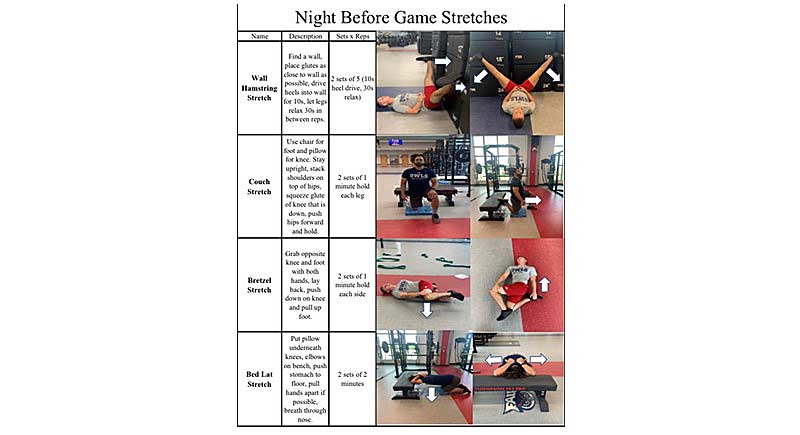
For away games, post-practice we give players an hour to shower and prepare to check in for the flight. Players are given lunch as they board the plane. We require that the players take three water bottles on the plane with them, along with a custom snack bag. The schedule is the same once we arrive at the hotel.
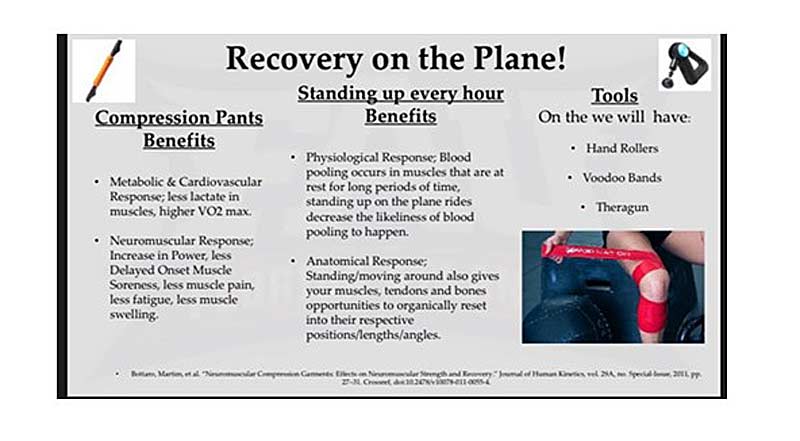
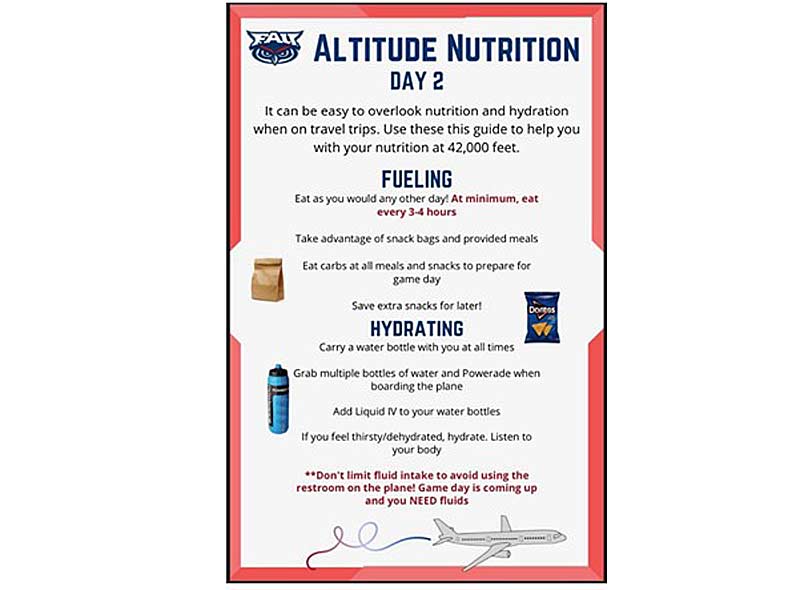
Saturday: Game Day
Game day is always different!
The excitement and anxiety of game day drives the intensity of the day. Players sleep until a reasonable time, trying to prevent any effects of sleep loss. As the players filter down for breakfast, they are handed a water bottle that they must drink.
Breakfast is a little looser in mood than the pregame meal, but it does feel distinctly more focused than the team dinner the night before. The meal is heavy carbs and protein-themed, as we want to fill that gas tank for performance later in the day. Post-breakfast, the players in their position groups do a walk and talk with their coaches around the hotel for around 15 minutes. The coaches go over tips and reminders during this time. If afforded by a later kickoff time, the athletes get around an hour break for downtime.
The players come back down roughly 7-8 hours prior to kickoff to watch tape and walk through for roughly an hour. Post walk-through, we do our game day priming workout. The workout duration is 15 minutes, consisting of a dynamic warm-up followed by three ballistic exercises:
- Plyo push-up 3×5 reps.
- Split squat jumps 3×3 each side.
- Seated start vertical jump 3×5.
“Ballistic activities might provide an alternative method of inducing a PAP response that is comparable in magnitude to that induced during heavy resistance exercise.” (Mark Russell, Natalie Williams, Liam P. Kilduff, Chapter 10: “Priming Match Day Performance,” Advanced Strength and Conditioning). We are trying to excite a PAP effect going into the game without inducing fatigue. This workout is performed 5-7 hours out of kickoff.
Once the priming workout is completed, the players are given a to-go meal. We encourage the players to take a hot shower and a 45-minute nap when they get back to their rooms. There is a two-hour gap between snack and the pregame meal. The pregame meal is four hours before kickoff. All players consume a Right Stuff with a Powerade. How much food they consume is up to each athlete, as they all have their own rituals leading up to kick.
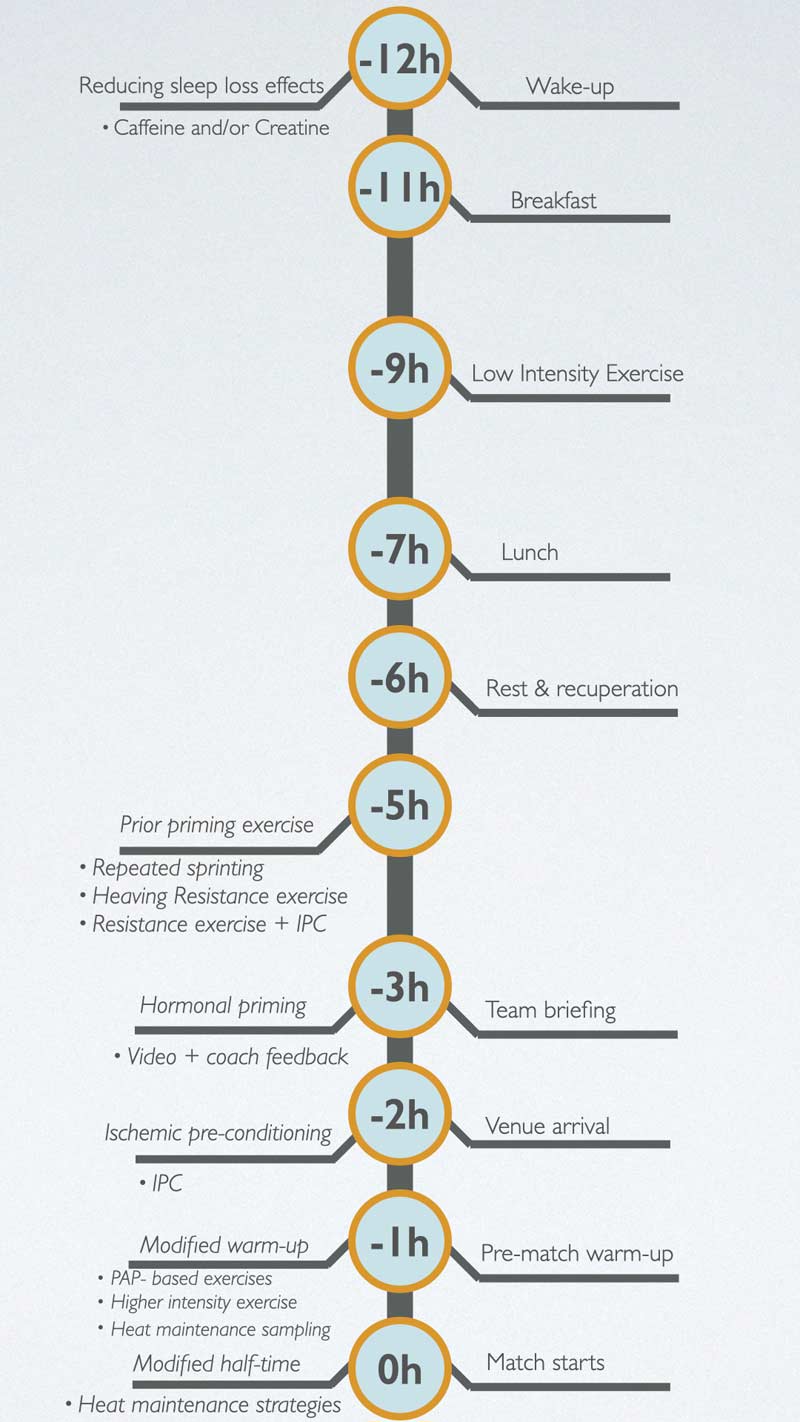
Following the meal, the team assembles for a special team callout followed by a briefing of what the head coach envisions for the game. Prior to loading the buses, the players watch a highlight tape, and then we leave the hotel for the stadium.
The aim is to get to the stadium around two hours prior to kick. Players arrive and immediately start pregame treatment or get taped in prep for the game. Heat is used pregame with heat pads, or if a home game, the hot tubs for no longer than five minutes. The chiropractor is available for pregame “tune-ups.” The strength staff is available for body tempering and targeted soft tissue work with the Theragun.
Around 1 hour 30 minutes out, players start to enter the field for position-specific warm-ups designed to dynamically warm up and prep the athlete for the game. Players are encouraged to keep headphones on and stay to themselves. Each strength coach is responsible for a position group and administers the warm-up. At 70 minutes prior to kick, the field is cleared, starting the football-specific buildup to kick.
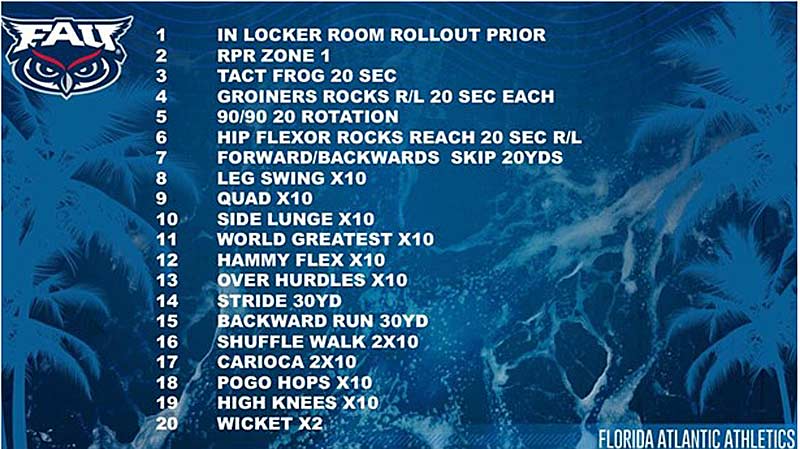
The football-specific warm-up lasts 35 minutes, and the field is then cleared with 23 minutes remaining on the countdown clock. Once reentering the locker room, the ATC and strength staff push fluid replenishment and hand out fast carb snacks such as gummies or candy. Any last-minute stretching (at the athlete’s request) is done prior to the coordinators’ briefing, followed by the head coach’s briefing. Once the head coach is finished addressing the team, they take the field.
During play, glucose and fluid replenishment is a priority. Our nutritionist aims to have our players consume 60-80 grams of carbs intra-game. We have exercise bikes on the sideline for players to stay warm during periods of inactivity, as well as the Theragun on the sideline for emergency soft tissue work. At halftime, each player has a custom snack bag with 60-80 grams of carbs coming in a variety of forms. The entire organization pushes hydration at halftime.
[adsanity align=’aligncenter’ id=11155]
Coaches make their adjustments and players reenter the field for a general, dynamic warm-up comprised of six exercises. After the final whistle (and hopefully a victory), players are given a recovery shake and a carb-heavy meal to go.
The players enjoy the night, and the process starts over. Although a grind, this work week is extremely fulfilling and exciting. Watching the team compete while feeling prepared and confident gives all three departments a sense of accomplishment. Any issues or adjustments within the week due to logistical issues—or, as we call it, “sudden change”—are immediately briefed amongst the departments and handled.
We are always chasing perfection, trying to catch excellence along the way. Share on XWe are always self-auditing the week as we progress through it, so any changes that will lead to better performance will be discussed. At the end of the season, all three heads of the three departments meet with the head football coach and discuss future changes or suggestions based on notes throughout the season. We are always chasing perfection, trying to catch excellence along the way.
Since you’re here…
…we have a small favor to ask. More people are reading SimpliFaster than ever, and each week we bring you compelling content from coaches, sport scientists, and physiotherapists who are devoted to building better athletes. Please take a moment to share the articles on social media, engage the authors with questions and comments below, and link to articles when appropriate if you have a blog or participate on forums of related topics. — SF
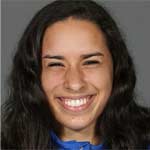 Autumn Bartlett joined the Florida Atlantic University staff in August 2021 as the football sports nutritionist. She graduated from the University of Florida in May 2020 with a dual degree in dietetics and nutrition science and completed her dietetic internship at Wellness Workdays.
Autumn Bartlett joined the Florida Atlantic University staff in August 2021 as the football sports nutritionist. She graduated from the University of Florida in May 2020 with a dual degree in dietetics and nutrition science and completed her dietetic internship at Wellness Workdays.
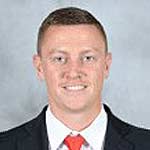 Adam Bennett joined Florida Atlantic University as an assistant athletic trainer in April 2015, working primarily with football. He then went to Minnesota for the 2016 season and returned to FAU in 2017 as the head athletic trainer for football. Before his first stint at FAU, Bennett interned with the Tampa Bay Buccaneers Athletic Training Department for a year, assisting with the prevention and rehabilitation of acute athletic injuries. He spent two years at the University of Southern Mississippi as a graduate assistant athletic trainer for football and women’s tennis while earning a master’s degree in sport management. Bennett got his B.S. in Athletic Training from Florida State while working with women’s soccer, football, baseball, and men’s basketball.
Adam Bennett joined Florida Atlantic University as an assistant athletic trainer in April 2015, working primarily with football. He then went to Minnesota for the 2016 season and returned to FAU in 2017 as the head athletic trainer for football. Before his first stint at FAU, Bennett interned with the Tampa Bay Buccaneers Athletic Training Department for a year, assisting with the prevention and rehabilitation of acute athletic injuries. He spent two years at the University of Southern Mississippi as a graduate assistant athletic trainer for football and women’s tennis while earning a master’s degree in sport management. Bennett got his B.S. in Athletic Training from Florida State while working with women’s soccer, football, baseball, and men’s basketball.
He is a Florida State Licensed NATABOC Certified Athletic Trainer and a NSCA Certified Strength and Conditioning Specialist.

